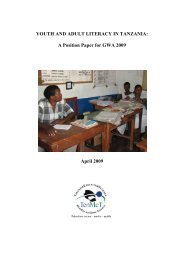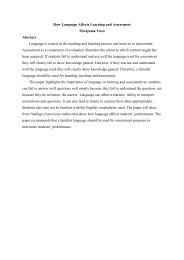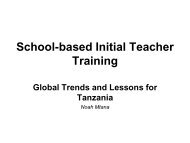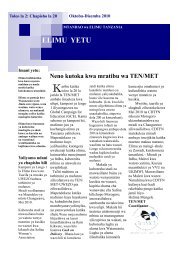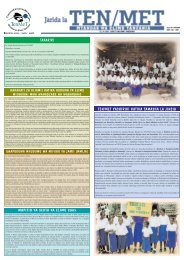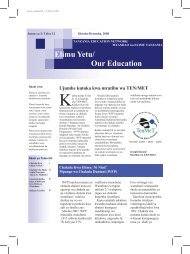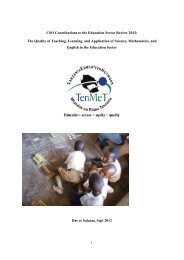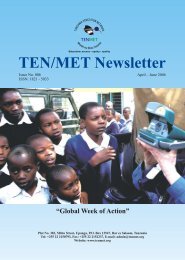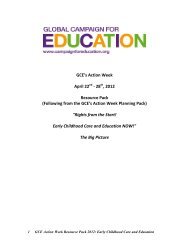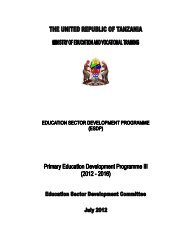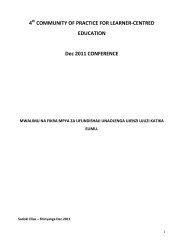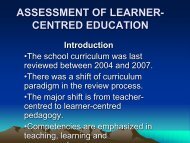Status of Children in Tanzania - 2012 - Tanzania Education Network ...
Status of Children in Tanzania - 2012 - Tanzania Education Network ...
Status of Children in Tanzania - 2012 - Tanzania Education Network ...
You also want an ePaper? Increase the reach of your titles
YUMPU automatically turns print PDFs into web optimized ePapers that Google loves.
Arusha<br />
Dodoma<br />
Kilimanjaro<br />
Manyara<br />
Morogoro<br />
Mtwara<br />
Pwani<br />
Sh<strong>in</strong>yanga<br />
Tanga<br />
Call for Action<br />
Figure 13. Current Food Security Situation <strong>in</strong> Tazanaia<br />
200,000<br />
180,000<br />
160,000<br />
140,000<br />
120,000<br />
100,000<br />
80,000<br />
60,000<br />
40,000<br />
20,000<br />
0<br />
Food <strong>in</strong>secure people<br />
Food requirement MT<br />
Seeds requirement MT<br />
SOURCE: Research f<strong>in</strong>d<strong>in</strong>gs <strong>2012</strong><br />
The <strong>Tanzania</strong> current food status <strong>in</strong>dicates that food security outlook is mixed reflect<strong>in</strong>g irregular<br />
pattern <strong>of</strong> ra<strong>in</strong>fall distribution. Sometimes sporadic ra<strong>in</strong>fall conditions or extended draught all these<br />
have significant <strong>in</strong>fluence to countries food security. Impliedly <strong>in</strong> other areas harvest might be good<br />
and <strong>in</strong> other areas very poor. All these make substantial number <strong>of</strong> households to obta<strong>in</strong> their food<br />
supplies from the market, mak<strong>in</strong>g food prices a key determ<strong>in</strong>ant <strong>of</strong> food access and food security.<br />
The situation <strong>of</strong> food supply and food security <strong>in</strong> urban areas is always <strong>in</strong> deficit as majority <strong>of</strong> the<br />
people cannot afford to get adequate food supply because <strong>of</strong> price factor. Research f<strong>in</strong>d<strong>in</strong>g from<br />
<strong>Tanzania</strong> Food Security Information Team (FSIT) <strong>2012</strong> <strong>in</strong>dicate that some regions have cereal<br />
deficit and others have non cereal deficit. In view <strong>of</strong> this Dar es Salaam, Dodoma, Arusha, and<br />
Manyara have a significant problem. See appendix 6 for more observation.<br />
Vulnerable areas for food <strong>in</strong>secure are evident <strong>in</strong> 21 regions as shown <strong>in</strong> appendix 7<br />
Food security affects mostly children who need to grow and develop. The food deficit at households<br />
affects mostly children who might stunt and fail to develop <strong>in</strong> their normal timetable. As noted <strong>in</strong><br />
other areas children do not get three meals per day, and others are compelled to skip the meals<br />
which subject them to torture and suffer<strong>in</strong>g. <strong>Children</strong> health has been at risk due to poor nutrition <strong>in</strong><br />
terms <strong>of</strong> food composition, most households due to weather vagaries had food shortage or food<br />
provided to children were <strong>of</strong> low quality meals <strong>of</strong> carbohydrates whose quantity was also<br />
<strong>in</strong>adequate. Some children were thus go<strong>in</strong>g to school e.g. Same and Iramba without even breakfast<br />
and the majority went without lunch <strong>in</strong> the afternoon. At school children were miss<strong>in</strong>g meals or<br />
when children went for lunch at other schools e.g. <strong>in</strong> Same district never returned <strong>in</strong> the afternoon<br />
session. Most schools did not have school feed<strong>in</strong>g programme. Therefore there was a significant<br />
<strong>in</strong>fluence <strong>of</strong> <strong>in</strong>adequate food supply and low academic achievement at schools, e.g. at place like<br />
Same, Ruvu and Kisiwani particularly among pastoral communities children were compelled to drop<br />
from schools because <strong>of</strong> unreliable food feed<strong>in</strong>g practices at households level.<br />
4.2.12 Factors mak<strong>in</strong>g children more vulnerable<br />
Income Poverty<br />
As per <strong>2012</strong> data children aged between 5 - 17 are 12,083,349 account<strong>in</strong>g for 31.4%. Just over half<br />
(50.8%) <strong>of</strong> the children aged 5-17 years are boys, among these 76.1% aged 5 -17 are liv<strong>in</strong>g <strong>in</strong> rural<br />
areas. Most <strong>of</strong> these children because <strong>of</strong> <strong>in</strong>come poverty are engaged <strong>in</strong> economical activities. ILO<br />
2010 revealed that 70.4% <strong>of</strong> children aged between 5 -17 are preoccupied <strong>in</strong> economic activities.<br />
As noted children from household with less than 100,000/=Tshs per month are engaged <strong>in</strong> child<br />
labour. These are those households associated with household poverty. Further 24.4% <strong>of</strong> children<br />
aged 5 -17 <strong>in</strong> <strong>Tanzania</strong> live <strong>in</strong> household headed by females, where children are engaged <strong>in</strong> both<br />
economic and housekeep<strong>in</strong>g. The survey <strong>in</strong>dicated that children aged between 5- 17 <strong>in</strong> <strong>Tanzania</strong><br />
ma<strong>in</strong>land 67.1% are engaged <strong>in</strong> both economic and housekeep<strong>in</strong>g activities. Those not work<strong>in</strong>g<br />
constitute 15.2%and those do<strong>in</strong>g only economic activities 3.3%. While <strong>in</strong> Zanzibar 57.1% are<br />
26 / 55 <strong>Tanzania</strong>-CRSA-REPORT-<strong>2012</strong><br />
A lov<strong>in</strong>g home for every child




